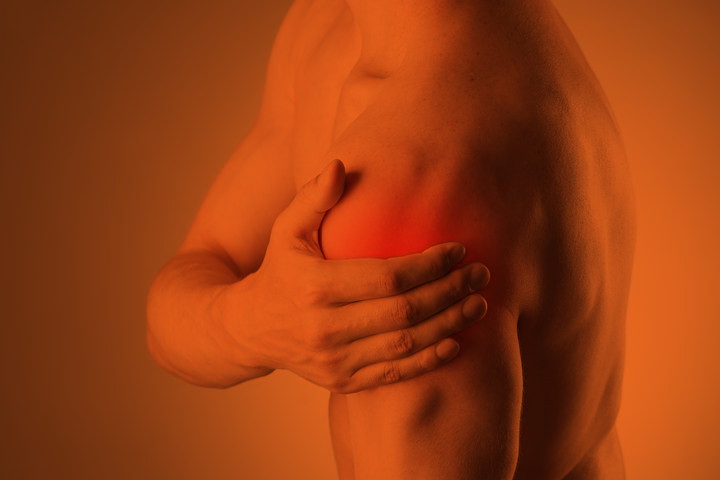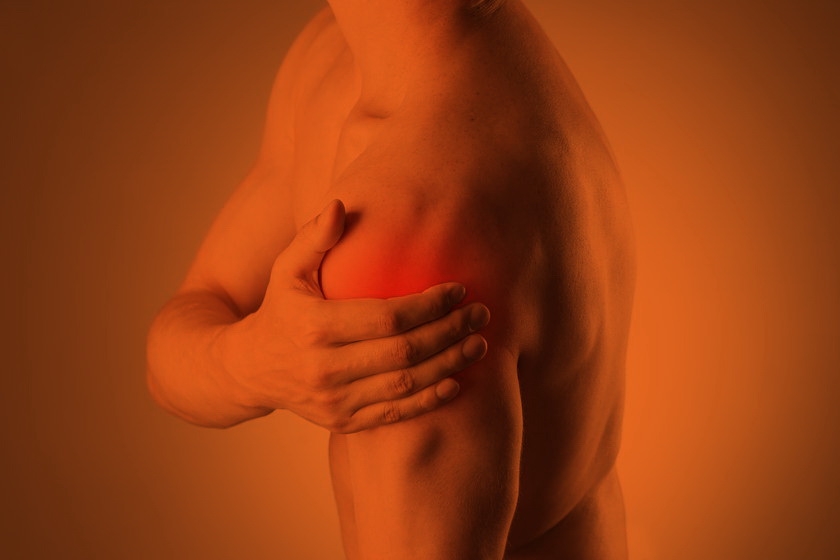
The rotator cuff is made up of four muscles that help move and stabilize the shoulder joint. Damage to any one of the four muscles or their ligaments that attach the muscle to bone can occur because of acute injury, chronic overuse, or gradual aging. This can cause significant pain and disability with range of motion or use of the shoulder joint.
Biceps tendonitis, Impingement syndrome, Bursitis, Calcific Tendonitis, frozen shoulder
▸ Pain and spasm, limited range of motion in the shoulder.
▸ The muscles do not make the small adjustments within the joint to allow the humeral head to move smoothly.
▸ Fluid accumulation within the joint due to inflammation limits movement.
▸ Arthritis and calcium deposits that form over time limit range of motion.
▸ Biceps tendonitis, Impingement syndrome, Bursitis, Calcific Tendonitis, Frozen shoulder
Our Athletic Therapists are dedicated to providing the most effective solution to your rotator cuff pain. We start by assessing the injury to test for damaged/weakened muscles. If there is significant weakness and pain, we recommend you to see a family doctor for diagnostic imaging.
The shoulder will try to protect itself by guarding the damaged muscle; this will alter the mechanics of the rotator cuff and exacerbate the injury. Tight guarding muscle needs to be released using myofascial release technique, Active Release Technique, as well as shoulder joint mobilizations to promote joint movement.
We also assess movement through cervical-thoracic spine to make sure there are no restrictions in movements. If restriction exists, we use mobilization and muscle energy technique to restore movement. Any lack of movement in this area will affect the way the postural muscles work and may exacerbate the rotator cuff injury.
At Evolution Sport Therapy, exercises are a crucial part of the healing process. Our Athletic Therapists walk you through re-patterning exercises and stretches for the rotator cuff, depending on the imbalance. This helps to increase scapular stabilization. We also create a home program for you that includes daily stretches/exercise and management protocols such as icing or heating.

The rotator cuff is made up of four muscles that help move and stabilize the shoulder joint. Damage to any one of the four muscles or their ligaments that attach the muscle to bone can occur because of acute injury, chronic overuse, or gradual aging. This can cause significant pain and disability with range of motion or use of the shoulder joint.
Biceps tendonitis, Impingement syndrome, Bursitis, Calcific Tendonitis, frozen shoulder
- Pain and spasm, limited range of motion in the shoulder.
- The muscles do not make the small adjustments within the joint to allow the humeral head to move smoothly.
- Fluid accumulation within the joint due to inflammation limits movement.
- Arthritis and calcium deposits that form over time limit range of motion.
- Biceps tendonitis, Impingement syndrome, Bursitis, Calcific Tendonitis, Frozen shoulder
Our Athletic Therapists are dedicated to providing the most effective solution to your rotator cuff pain. We start by assessing the injury to test for damaged/weakened muscles. If there is significant weakness and pain, we recommend you to see a family doctor for diagnostic imaging.
The shoulder will try to protect itself by guarding the damaged muscle; this will alter the mechanics of the rotator cuff and exacerbate the injury. Tight guarding muscle needs to be released using myofascial release technique, Active Release Technique, as well as shoulder joint mobilizations to promote joint movement.
We also assess movement through cervical-thoracic spine to make sure there are no restrictions in movements. If restriction exists, we use mobilization and muscle energy technique to restore movement. Any lack of movement in this area will affect the way the postural muscles work and may exacerbate the rotator cuff injury.
At Evolution Sport Therapy, exercises are a crucial part of the healing process. Our Athletic Therapists walk you through re-patterning exercises and stretches for the rotator cuff, depending on the imbalance. This helps to increase scapular stabilization. We also create a home program for you that includes daily stretches/exercise and management protocols such as icing or heating.

The rotator cuff is made up of four muscles that help move and stabilize the shoulder joint. Damage to any one of the four muscles or their ligaments that attach the muscle to bone can occur because of acute injury, chronic overuse, or gradual aging. This can cause significant pain and disability with range of motion or use of the shoulder joint.
Biceps tendonitis, Impingement syndrome, Bursitis, Calcific Tendonitis, frozen shoulder
- Pain and spasm, limited range of motion in the shoulder.
- The muscles do not make the small adjustments within the joint to allow the humeral head to move smoothly.
- Fluid accumulation within the joint due to inflammation limits movement.
- Arthritis and calcium deposits that form over time limit range of motion.
- Biceps tendonitis, Impingement syndrome, Bursitis, Calcific Tendonitis, Frozen shoulder
Our Athletic Therapists are dedicated to providing the most effective solution to your rotator cuff pain. We start by assessing the injury to test for damaged/weakened muscles. If there is significant weakness and pain, we recommend you to see a family doctor for diagnostic imaging.
The shoulder will try to protect itself by guarding the damaged muscle; this will alter the mechanics of the rotator cuff and exacerbate the injury. Tight guarding muscle needs to be released using myofascial release technique, Active Release Technique, as well as shoulder joint mobilizations to promote joint movement.
We also assess movement through cervical-thoracic spine to make sure there are no restrictions in movements. If restriction exists, we use mobilization and muscle energy technique to restore movement. Any lack of movement in this area will affect the way the postural muscles work and may exacerbate the rotator cuff injury.
At Evolution Sport Therapy, exercises are a crucial part of the healing process. Our Athletic Therapists walk you through re-patterning exercises and stretches for the rotator cuff, depending on the imbalance. This helps to increase scapular stabilization. We also create a home program for you that includes daily stretches/exercise and management protocols such as icing or heating.

The rotator cuff is made up of four muscles that help move and stabilize the shoulder joint. Damage to any one of the four muscles or their ligaments that attach the muscle to bone can occur because of acute injury, chronic overuse, or gradual aging. This can cause significant pain and disability with range of motion or use of the shoulder joint.
Biceps tendonitis, Impingement syndrome, Bursitis, Calcific Tendonitis, frozen shoulder
- Pain and spasm, limited range of motion in the shoulder.
- The muscles do not make the small adjustments within the joint to allow the humeral head to move smoothly.
- Fluid accumulation within the joint due to inflammation limits movement.
- Arthritis and calcium deposits that form over time limit range of motion.
- Biceps tendonitis, Impingement syndrome, Bursitis, Calcific Tendonitis, Frozen shoulder
Our Athletic Therapists are dedicated to providing the most effective solution to your rotator cuff pain. We start by assessing the injury to test for damaged/weakened muscles. If there is significant weakness and pain, we recommend you to see a family doctor for diagnostic imaging.
The shoulder will try to protect itself by guarding the damaged muscle; this will alter the mechanics of the rotator cuff and exacerbate the injury. Tight guarding muscle needs to be released using myofascial release technique, Active Release Technique, as well as shoulder joint mobilizations to promote joint movement.
We also assess movement through cervical-thoracic spine to make sure there are no restrictions in movements. If restriction exists, we use mobilization and muscle energy technique to restore movement. Any lack of movement in this area will affect the way the postural muscles work and may exacerbate the rotator cuff injury.
At Evolution Sport Therapy, exercises are a crucial part of the healing process. Our Athletic Therapists walk you through re-patterning exercises and stretches for the rotator cuff, depending on the imbalance. This helps to increase scapular stabilization. We also create a home program for you that includes daily stretches/exercise and management protocols such as icing or heating.
© Copyright Evolution Sport Therapy 2025.
Newsletter Signup
Sign up for our newsletter to receive all the latest!
Newsletter Signup
Sign up for our newsletter to receive all the latest!
© Copyright Evolution Sport Therapy 2025.
Newsletter Signup
Sign up for our newsletter to receive all the latest!
© Copyright Evolution Sport Therapy 2025.